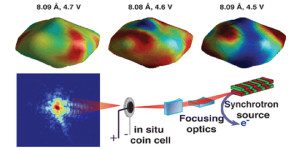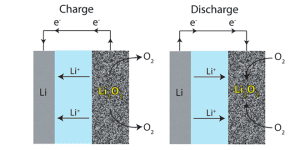Researchers at Argonne National Laboratory are using a new imaging technique to learn more about the process that causes lithium-ion batteries to degrade over time. Using coherent X-ray diffractive imaging at the DOE’s Advanced Photon Source facility, a team of researchers mapped the three-dimensional strain in individual nanoparticles within the electrodes of operating batteries. In… Read more »
Search Results Found For: "Argonne "
DOE-supported research projects seek to commercialize silicon-based anodes
The DOE is supporting six applied battery research projects, with the objective of developing cells that provide energy density of more than 200 Wh/kg, along with long cycle life and excellent abuse tolerance. All six projects are using some form of silicon-based material for the anode. A team led by the Argonne National Laboratory is… Read more »
Wildcat’s new copper fluoride cathode material offers 2.5x more capacity than today’s battery tech
The current generation of lithium-ion battery materials is quickly approaching its theoretical limit. In commercial layered oxide cathodes, like the popular nickel-manganese-cobalt (NMC), there is only one lithium ion for every metal. So, the most energy you could possibly store with those materials is one full lithium in and out, or about 300 mAh per… Read more »
US/Chinese/Korean research team details the challenges of Li-air battery research
Lithium-air batteries are widely expected to be the next big thing – more than 300 research papers have been published on the topic in the past 3 years. Li-air has the potential to deliver far more energy density than current lithium-ion technology. A new review in the ACS journal Chemical Reviews sums up the current… Read more »
CalBattery’s new SiGr anode material hopes to break the battery bottleneck
California Lithium Battery took advantage of national and local government programs so it could focus on its revolutionary silicon-graphene anode material. Now with EV, electronics, and energy storage customers lining up, it hopes to break the battery bottleneck. When you think about a bottleneck, you think about constriction – something that moves in a particular… Read more »
BASF expands battery R&D facility
BASF has announced that it will invest $25 million to renovate and expand its R&D facility in Beachwood, Ohio. In addition to the existing catalyst and battery materials research, the facility is being renovated to make space for a new cathode materials research team. Construction is underway and completion is expected in early 2014. The… Read more »
Battery makers expect to cut prices in half by 2020
Executives at two leading battery makers said this week that the cost of lithium-ion batteries is steadily declining, and could well drop to half of today’s price by 2020. “We have an internal target to go down by at least a factor of two by 2020,” said LG Chem Power CEO Prabhakar Patil, at this… Read more »
NOHMs Technologies establishes Li-S battery manufacturing facility in Kentucky
NOHMs Technologies, a lithium-sulfur battery spin-off from Cornell University, will locate a new research, manufacturing and product development facility in Lexington, Kentucky. The company will use the Kentucky-Argonne Battery Manufacturing Research and Development Center, a partnership of the Argonne National Laboratory, the state and the Universities of Kentucky and Louisville. Ford, Hitachi and Toyota are some… Read more »
Advanced battery testing and development hub opens in Indiana
The Battery Innovation Center (BIC), a hub for advanced battery testing and development, opened this week in Newberry, Indiana. The 32,000-square-foot facility will serve as a center for research and development, prototyping and contract manufacturing for industrial, academic and military customers. BIC members include corporate, academic and government entities such as AeroVironment, Eaton, Purdue University… Read more »
New US-Europe Interoperability Center will promote EV-smart grid cooperation
The interaction between smart grids and EVs is expected to be a key part of the transition to electric mobility. The grid of the future will provide two-way communication between suppliers and consumers, responding to the actions of all users and ensuring efficient, sustainable power systems with low losses and high security. Promoting common standards… Read more »













